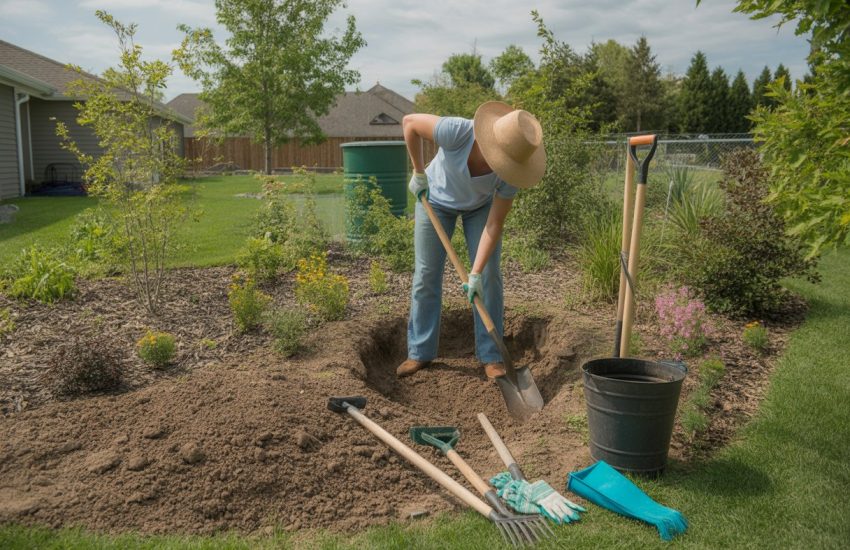How to Propagate Wisteria: A Clear Guide for Beginners
Wisteria is a beautiful and fragrant vine that is easy to grow and propagate. Propagating wisteria is a great way to expand your garden or share this stunning plant with others. Wisteria can be propagated through several methods, including layering, cuttings, and grafting. In this article, we will explore the various ways to propagate wisteria and provide step-by-step instructions for each method.
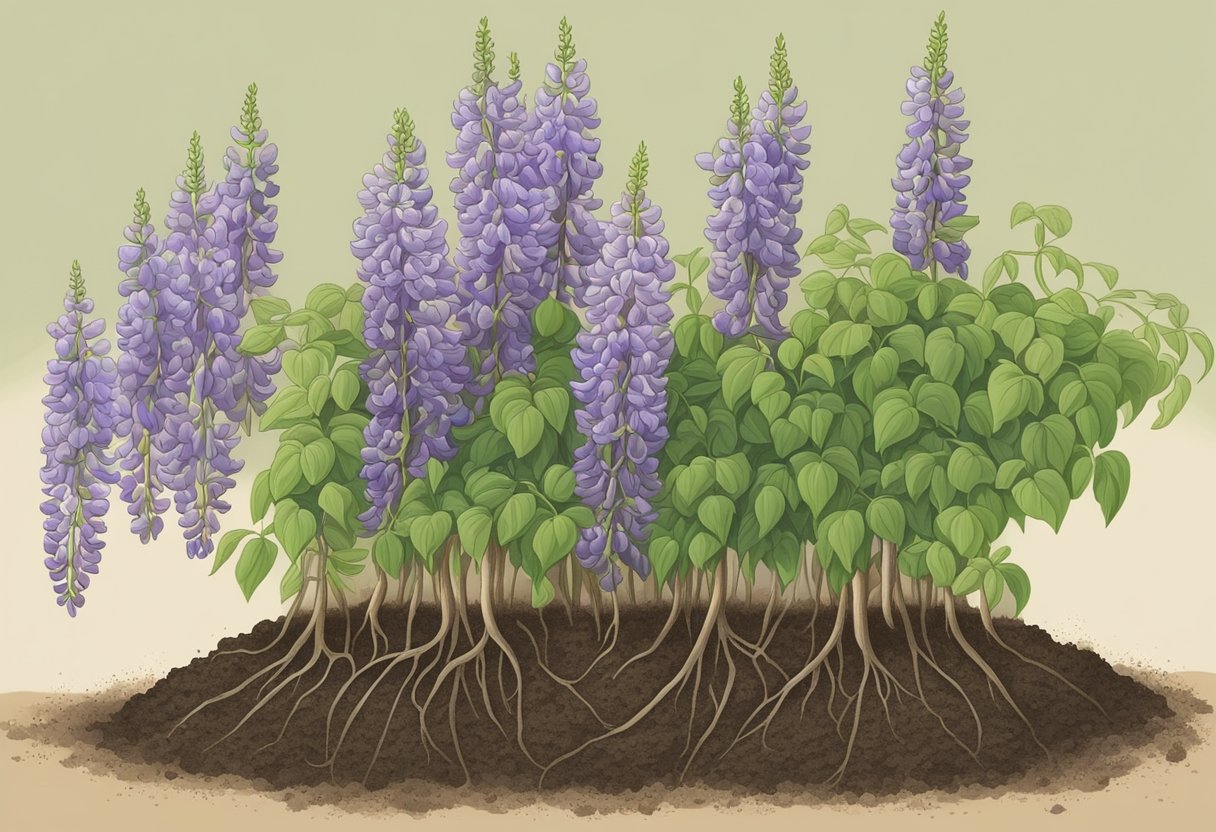
Layering is the most common and easiest way to propagate wisteria. This method involves bending a low-growing branch to the ground and burying it in soil. The branch will develop roots and can be cut from the parent plant once it has established itself. Cuttings are another popular method of propagating wisteria. This involves taking a cutting from the parent plant and rooting it in soil or water. Grafting is a more advanced method that involves combining the desired wisteria variety with a hardy rootstock to create a stronger plant.
By learning how to propagate wisteria, gardeners can create new plants for their own gardens or share this beautiful plant with others. Whether you choose to propagate wisteria through layering, cuttings, or grafting, the process is simple and rewarding. In the following sections, we will provide detailed instructions for each method so that you can successfully propagate your own wisteria plants.
Understanding Wisteria Propagation
Types of Wisteria
Wisteria is a genus of flowering plants in the legume family. There are two main types of wisteria: Chinese wisteria (Wisteria sinensis) and Japanese wisteria (Wisteria floribunda). Chinese wisteria is known for its fragrant, lavender-blue flowers, while Japanese wisteria has longer, pale purple flowers.
Propagation Methods Overview
There are several methods for propagating wisteria, including cuttings, layering, and seed. Each method has its own advantages and disadvantages.
- Cuttings: Propagating wisteria from cuttings involves taking a stem cutting from a healthy plant and rooting it in soil or water. This method is relatively easy and can produce a new plant quickly, but it may not produce an exact replica of the parent plant.
- Layering: Layering involves bending a branch of the parent plant to the ground and burying a portion of it in soil. The buried portion will eventually develop roots and can be cut from the parent plant to create a new plant. This method can take longer than cuttings, but it produces a new plant that is genetically identical to the parent plant.
- Seed: Propagating wisteria from seed is the most difficult method, as wisteria seeds require specific conditions to germinate. However, this method can produce a large number of new plants, and the resulting plants may exhibit genetic variation.
Overall, understanding the different methods of wisteria propagation can help gardeners choose the best method for their needs and successfully propagate new plants.
Preparation for Propagation
Choosing the Right Time of Year
Choosing the right time of year is crucial when propagating wisteria. The best time to take cuttings is in early summer or late spring when the plant is actively growing. Early spring is also suitable for taking hardwood cuttings. It is important to avoid taking cuttings during the winter months when the plant is dormant.
Selecting Healthy Plant Material
Selecting healthy plant material is essential for successful propagation. Choose a healthy, disease-free plant with vigorous growth and good foliage. Look for a node on the stem that is at least 6 inches long. Cut the stem just below the node at a 45-degree angle with a sharp, clean pair of pruning shears.
To ensure the best chance of success, it is recommended to take softwood cuttings rather than hardwood cuttings. Softwood cuttings are taken from the current season’s growth and are more likely to root successfully. Hardwood cuttings are taken from the previous season’s growth and are more difficult to root.
In summary, to prepare for propagation of wisteria, choose a healthy plant with vigorous growth and good foliage, and take softwood cuttings in early summer or late spring. By following these steps, you can increase your chances of successfully propagating wisteria.
Propagation by Cuttings
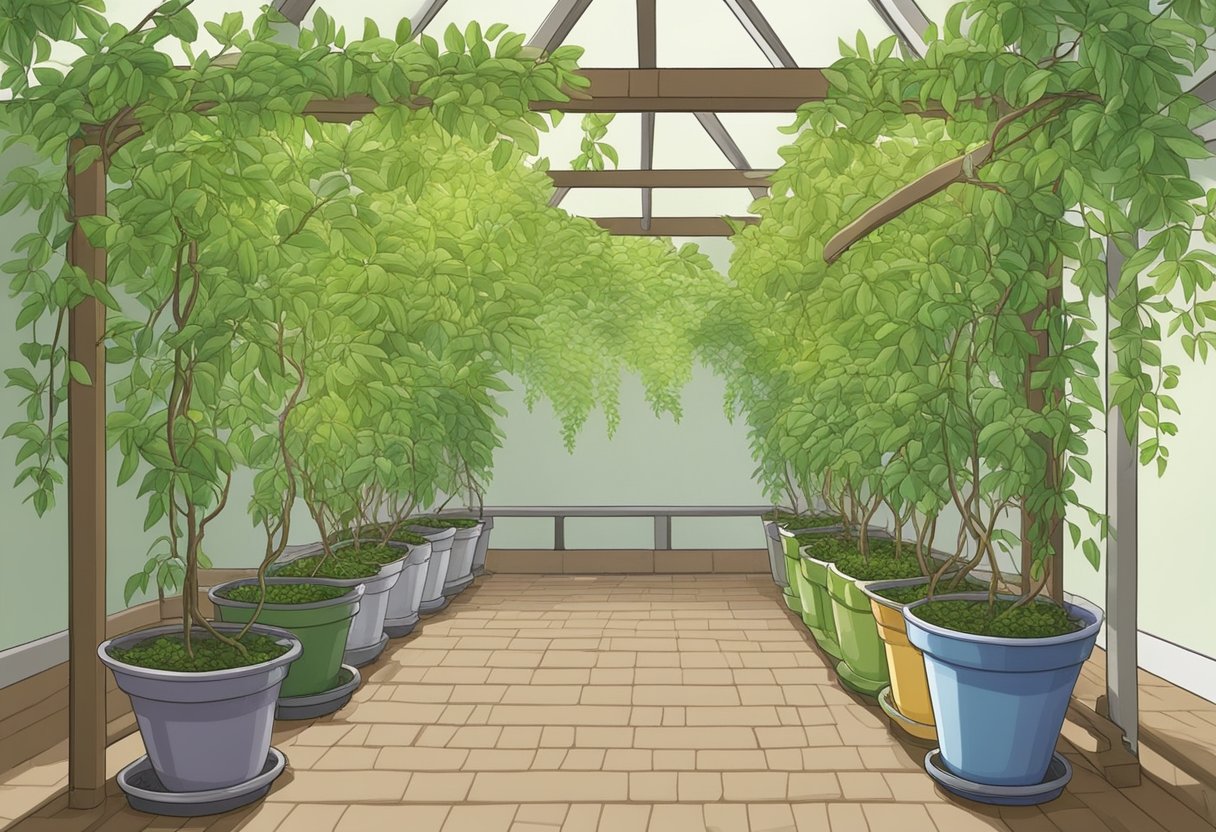
Taking Softwood Cuttings
Softwood cuttings are taken from new growth that is still green and flexible. This is usually done in the spring or early summer. Cut a stem that is about 4-6 inches long, just below a node, which is where the leaves attach to the stem. Remove the leaves from the bottom half of the stem and dip the cut end in rooting hormone. Plant the cutting in moist potting soil and cover it with a plastic bag to maintain humidity. Keep the cutting in indirect light and make sure the soil stays moist. The cutting should root in about 4-6 weeks.
Taking Hardwood Cuttings
Hardwood cuttings are taken from older growth that has hardened off. This is usually done in the fall or winter when the plant is dormant. Cut a stem that is about 8-12 inches long, just below a node. Remove the leaves from the bottom half of the stem and dip the cut end in rooting hormone. Plant the cutting in well-drained soil and cover it with a plastic bag to maintain humidity. Keep the cutting in indirect light and make sure the soil stays moist. The cutting should root in about 8-12 weeks.
Rooting Process for Cuttings
Regardless of whether you take softwood or hardwood cuttings, the rooting process is the same. The key is to keep the cuttings moist and in a humid environment. Using a rooting hormone can also help speed up the process. Once the cuttings have rooted, they can be transplanted into individual pots or directly into the ground. Make sure to keep the soil moist and provide the plant with indirect light until it has established a strong root system.
Propagation by Layering
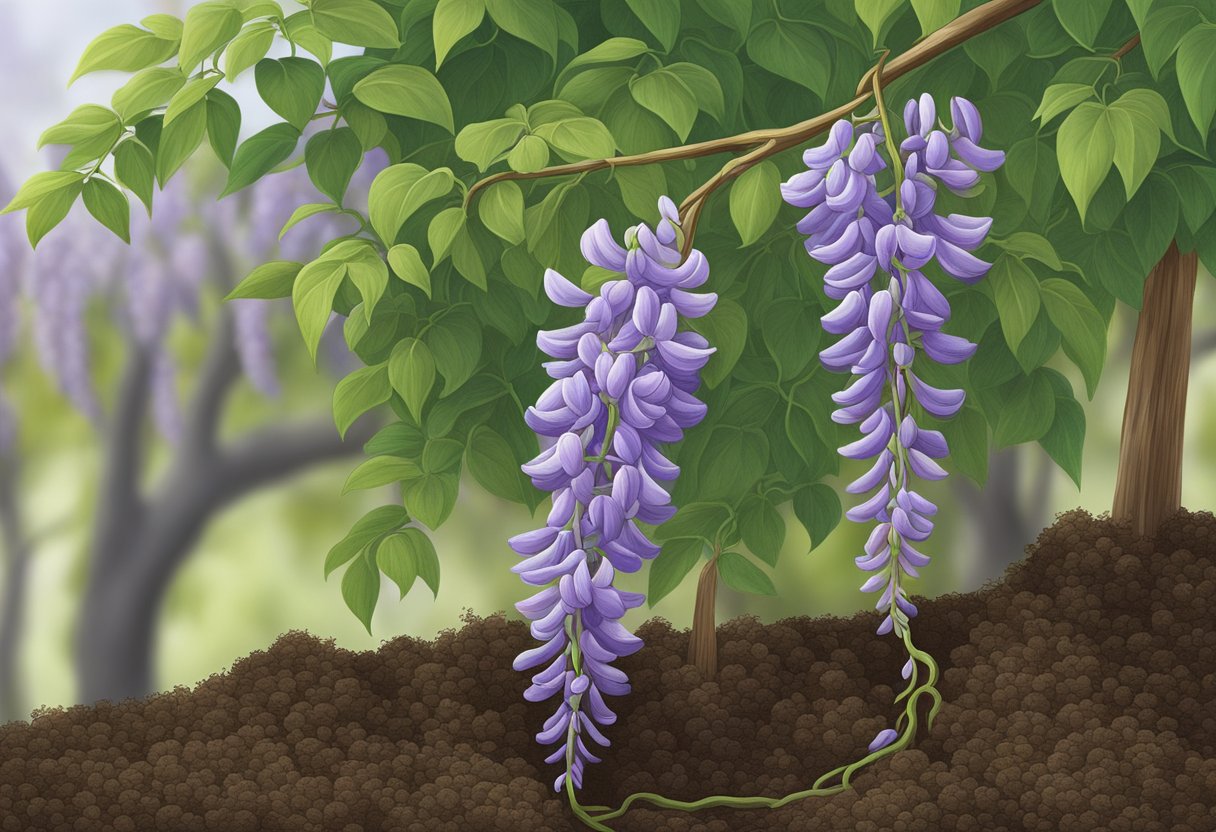
Wisteria can be propagated by layering, which involves burying a portion of the stem or branch of the parent plant in the soil to encourage the growth of new roots and shoots. This method is particularly useful for plants that are difficult to propagate by other means.
Simple Layering Technique
To propagate wisteria using the simple layering technique, follow these steps:
- Identify a healthy stem or branch on the parent plant that is flexible and can be bent down to the ground.
- Remove any leaves or side shoots from the portion of the stem that will be buried in the soil.
- Make a small cut in the bark of the stem on the underside, about 1 inch (2.5 cm) from the tip.
- Bury the cut portion of the stem in the soil, leaving the tip exposed.
- Secure the buried portion of the stem in place with a U-shaped stake or a small rock.
- Water the soil around the buried stem to keep it moist.
- After a few months, check the buried stem for signs of new root growth. Once roots have formed, the new plant can be separated from the parent plant and transplanted to a new location.
Air Layering Method
The air layering method is another way to propagate wisteria using layering. This method involves creating a small wound in the stem of the parent plant and then wrapping it with moist soil or sphagnum moss to encourage the growth of new roots. Follow these steps:
- Identify a healthy stem or branch on the parent plant that is at least 1 year old and about the thickness of a pencil.
- Make a small cut in the bark of the stem, about 1 inch (2.5 cm) from the tip.
- Use a toothpick to pry open the cut and expose the inner wood of the stem.
- Apply a small amount of rooting hormone to the exposed wood.
- Wrap the exposed portion of the stem with moist soil or sphagnum moss.
- Cover the soil or moss with plastic wrap and secure it in place with tape.
- Check the soil or moss regularly to make sure it stays moist.
- After a few months, check the wrapped portion of the stem for signs of new root growth. Once roots have formed, the new plant can be separated from the parent plant and transplanted to a new location.
When layering wisteria, it is important to use well-draining soil that is kept moist but not waterlogged. The buried stem or wrapped portion of the stem should have at least one node, which is where new roots and shoots will form. With patience and care, layering can be a successful method for propagating wisteria.
Caring for New Wisteria Plants
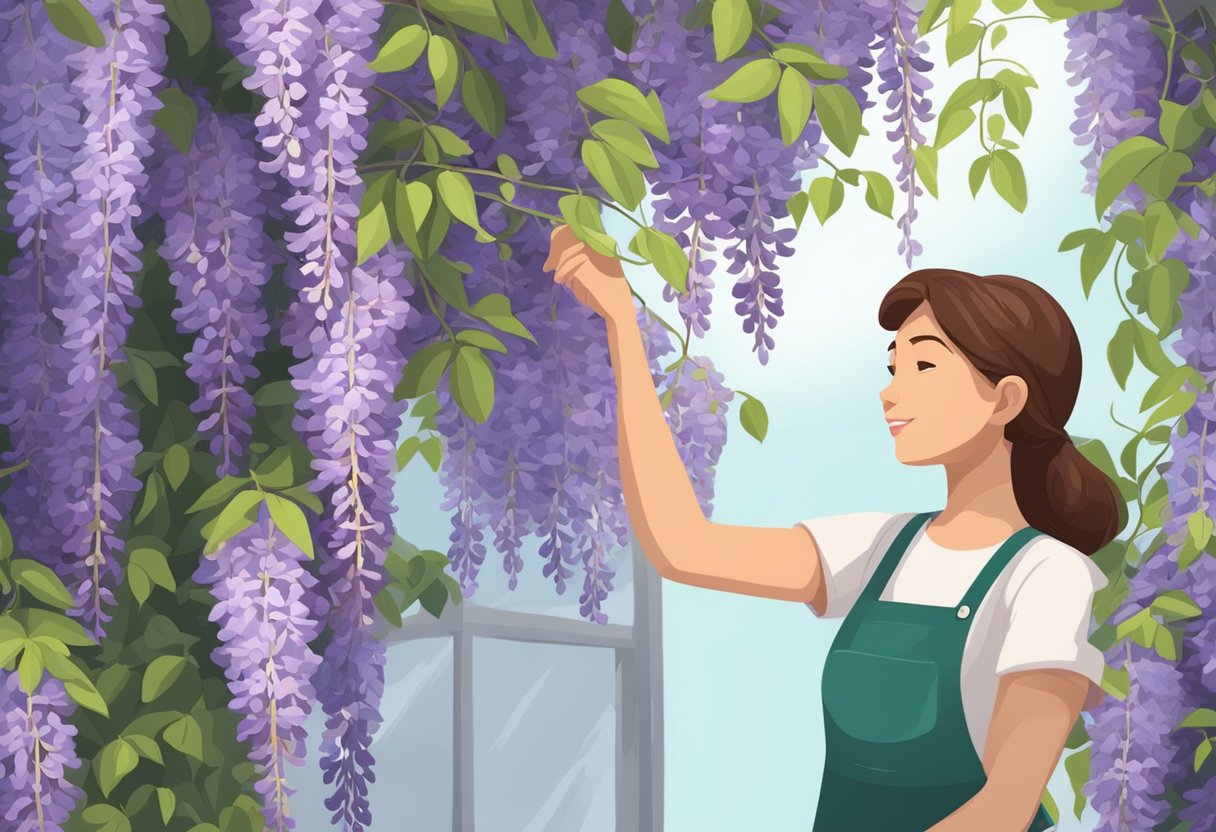
Once you have successfully propagated wisteria, it is important to care for the new plants to ensure that they grow healthy and strong. This section will cover the essential aspects of caring for new wisteria plants, including watering and feeding, pruning and training, and transplanting to a permanent location.
Watering and Feeding
Newly propagated wisteria plants require regular watering and feeding to establish themselves and grow strong roots. It is important to water the plants deeply and regularly, ensuring that the soil is moist but not waterlogged. The frequency of watering will depend on the climate and soil conditions, but as a general rule, wisteria plants require more water during hot and dry weather.
Feeding the plants with a balanced fertilizer will also help them to establish themselves and grow strong. Use a fertilizer that is high in phosphorus to encourage root growth, and apply it according to the manufacturer’s instructions.
Pruning and Training
Pruning and training are essential aspects of caring for wisteria plants, as they help to shape the plant and encourage healthy growth. Prune the plants in late winter or early spring, cutting back any dead or damaged growth and removing any suckers that have grown from the base of the plant.
To train the plants, use a sturdy support structure such as a trellis or pergola, and tie the stems to the structure using soft twine or plant ties. Train the stems in the desired direction, and remove any side shoots that grow from the main stem.
Transplanting to a Permanent Location
Once the wisteria plants have established themselves and grown strong roots, they can be transplanted to a permanent location in the garden. Choose a location that receives full sun or partial shade, and prepare the soil by digging a hole that is twice the size of the plant’s root ball.
Mix well-draining potting soil with organic matter such as compost or well-rotted manure, and backfill the hole, ensuring that the plant is planted at the same depth as it was in its previous container. Water the plant thoroughly after transplanting, and continue to water it regularly until it is established.
By following these essential care tips, you can ensure that your newly propagated wisteria plants grow healthy and strong, providing you with beautiful blooms for years to come.
Troubleshooting Common Issues

Dealing with Pests and Diseases
Wisteria plants are susceptible to a variety of pests and diseases, which can cause damage to the plant and hinder its growth. Here are some common pests and diseases that affect wisteria plants and how to deal with them:
Aphids: These small insects can cause damage to the leaves and stems of wisteria plants. To get rid of aphids, spray the plant with a strong jet of water or use an insecticidal soap.
Spider mites: These tiny pests can cause yellowing of the leaves and a fine webbing on the plant. To control spider mites, spray the plant with a strong jet of water or use a miticide.
Powdery mildew: This fungal disease can cause a white powdery coating on the leaves and stems of wisteria plants. To control powdery mildew, remove any infected plant parts and spray the plant with a fungicide.
Leaf spot: This fungal disease can cause brown spots on the leaves of wisteria plants. To control leaf spot, remove any infected plant parts and spray the plant with a fungicide.
Managing Invasive Growth
Wisteria plants are known for their aggressive growth and can quickly take over an area if not properly managed. Here are some tips for managing the invasive growth of wisteria plants:
Pruning: Regular pruning is essential to keep wisteria plants under control. Prune the plant in late winter or early spring before new growth appears. Remove any dead, damaged, or diseased wood and cut back any unwanted growth.
Training: Train the wisteria plant to grow in the desired direction by tying the stems to a support structure. This will help to prevent the plant from spreading out of control.
Root pruning: Wisteria plants can also spread through their roots. To prevent this, dig a trench around the plant and cut through any roots that are spreading too far.
By following these tips, you can keep your wisteria plants healthy and under control, ensuring that they continue to thrive for years to come.
Wisteria Varieties and Their Specific Needs

Wisteria Sinensis (Chinese Wisteria)
Wisteria Sinensis, commonly known as Chinese Wisteria, is a deciduous climbing plant that is native to China. It is one of the most popular wisteria varieties due to its stunning, fragrant, and abundant flowers. The flowers can be purple, white, or pink and appear in late spring to early summer.
Chinese Wisteria prefers full sun exposure and well-draining soil. It can tolerate a range of soil pH levels but prefers slightly acidic soil. It is a vigorous grower and can reach up to 30 feet in height if left unpruned. Therefore, it is essential to regularly prune it to maintain its shape and size.
Wisteria Floribunda (Japanese Wisteria)
Wisteria Floribunda, commonly known as Japanese Wisteria, is a deciduous climbing plant that is native to Japan. It is another popular wisteria variety due to its long, fragrant, and showy flower clusters. The flowers can be purple, white, or pink and appear in late spring to early summer.
Japanese Wisteria prefers full sun exposure and well-draining soil. It can tolerate a range of soil pH levels but prefers slightly acidic soil. It is a less vigorous grower than Chinese Wisteria and can reach up to 20 feet in height if left unpruned. Regular pruning is also necessary to maintain its shape and size.
Wisteria Frutescens (American Wisteria)
Wisteria Frutescens, commonly known as American Wisteria, is a deciduous climbing plant that is native to the southeastern United States. It is a less commonly grown wisteria variety but is still a beautiful addition to any garden. The flowers are less showy than Chinese and Japanese Wisteria and are usually light purple or white.
American Wisteria prefers full sun exposure and well-draining soil. It can tolerate a range of soil pH levels but prefers slightly acidic soil. It is a slow grower and can reach up to 15 feet in height if left unpruned. Pruning is necessary to maintain its shape and size.
In conclusion, each wisteria variety has its specific needs, but they all prefer full sun exposure and well-draining soil. Regular pruning is also necessary to maintain their shape and size. By understanding the specific needs of each variety, gardeners can successfully propagate and grow beautiful wisteria plants in their gardens.
Frequently Asked Questions

What are the steps to propagate wisteria from seed?
To propagate wisteria from seed, first, you need to scarify the seed coat by rubbing it with sandpaper or nicking it with a knife. Then, soak the seeds in warm water for 24-48 hours before planting them in a well-draining potting mix. Keep the soil moist and warm, and the seeds should germinate within 2-4 weeks.
Can you root wisteria cuttings in water, and if so, how?
Yes, you can root wisteria cuttings in water. Take 6-8 inch long cuttings from the current season’s growth, remove the leaves from the bottom half, and place the cuttings in a jar of water. Change the water every few days and keep the jar in a warm, bright location. The cuttings should root within 4-6 weeks.
How long does it typically take for wisteria cuttings to root?
Wisteria cuttings typically take 4-6 weeks to root. However, it may take longer or shorter depending on the environmental conditions and the health of the cutting.
What is the process for propagating wisteria by layering?
To propagate wisteria by layering, select a low-growing, flexible stem and bend it down to the ground. Make a small wound on the underside of the stem where it touches the soil, and cover the wound with soil. Keep the soil moist, and the stem should root within a few months. Once rooted, you can cut the stem from the parent plant and transplant it.
Is it possible to grow wisteria from a branch, and what is the method?
Yes, it is possible to grow wisteria from a branch. Take a 6-8 inch long branch from the current season’s growth, remove the leaves from the bottom half, and plant the branch in a well-draining potting mix. Keep the soil moist and warm, and the branch should root within 4-6 weeks.
How can you successfully propagate wisteria from runners?
To propagate wisteria from runners, simply dig up the runner and cut it into sections with a sharp knife. Each section should have at least one bud and some roots. Plant the sections in a well-draining potting mix, keep the soil moist, and the sections should root within a few weeks.

